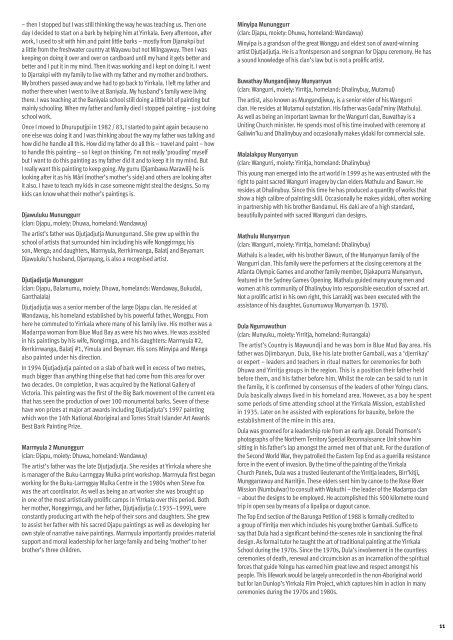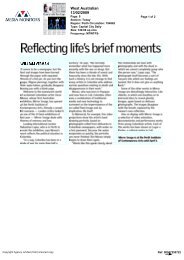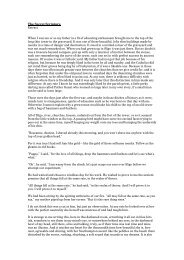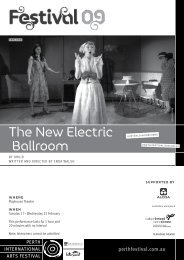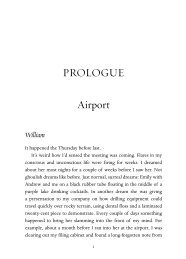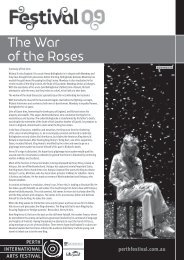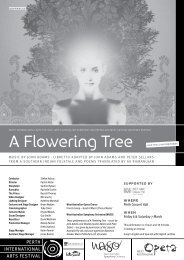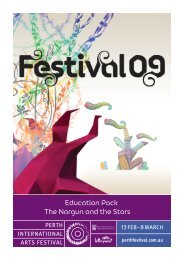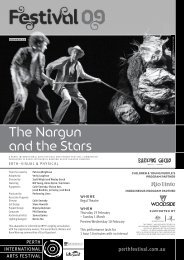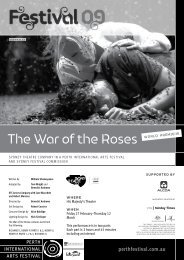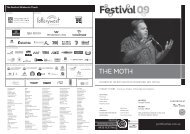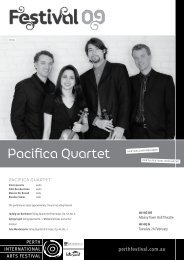Visual Arts - 2009 - Perth International Arts Festival
Visual Arts - 2009 - Perth International Arts Festival
Visual Arts - 2009 - Perth International Arts Festival
You also want an ePaper? Increase the reach of your titles
YUMPU automatically turns print PDFs into web optimized ePapers that Google loves.
– then I stopped but I was still thinking the way he was teaching us. Then one<br />
day I decided to start on a bark by helping him at Yirrkala. Every afternoon, after<br />
work, I used to sit with him and paint little barks – mostly from Djarrakpi but<br />
a little from the freshwater country at Wayawu but not Milngaywuy. Then I was<br />
keeping on doing it over and over on cardboard until my hand it gets better and<br />
better and I put it in my mind. Then it was working and I kept on doing it. I went<br />
to Djarrakpi with my family to live with my father and my mother and brothers.<br />
My brothers passed away and we had to go back to Yirrkala. I left my father and<br />
mother there when I went to live at Baniyala. My husband’s family were living<br />
there. I was teaching at the Baniyala school still doing a little bit of painting but<br />
mainly schooling. When my father and family died I stopped painting – just doing<br />
school work.<br />
Once I moved to Dhuruputjpi in 1982 / 83, I started to paint again because no<br />
one else was doing it and I was thinking about the way my father was talking and<br />
how did he handle all this. How did my father do all this – travel and paint – how<br />
to handle this painting – so I kept on thinking. I’m not really ‘prouding’ myself<br />
but I want to do this painting as my father did it and to keep it in my mind. But<br />
I really want this painting to keep going. My gurru (Djambawa Marawili) he is<br />
looking after it as his Måri (mother’s mother’s side) and others are looking after<br />
it also. I have to teach my kids in case someone might steal the designs. So my<br />
kids can know what their mother’s paintings is.<br />
Djawuluku Mununggurr<br />
(clan: Djapu, moiety: Dhuwa, homeland: Wandawuy)<br />
The artist’s father was Djutjadjutja Munungurrand. She grew up within the<br />
school of artists that surrounded him including his wife Nonggirrnga; his<br />
son, Menga; and daughters, Marrnyula, Rerrkirrwanga, Balatj and Beyamarr.<br />
Djawuluku’s husband, Djarrayang, is also a recognised artist.<br />
Djutjadjutja Mununggurr<br />
(clan: Djapu, Balamumu, moiety: Dhuwa, homelands: Wandaway, Bukudal,<br />
Garrthalala)<br />
Djutjadjutja was a senior member of the large Djapu clan. He resided at<br />
Wandawuy, his homeland established by his powerful father, Wonggu. From<br />
here he commuted to Yirrkala where many of his family live. His mother was a<br />
Madarrpa woman from Blue Mud Bay as were his two wives. He was assisted<br />
in his paintings by his wife, Nongirrnga, and his daughters: Marrnyula #2,<br />
Rerrkirrwanga, Balatj #1, Yimula and Beymarr. His sons Minyipa and Menga<br />
also painted under his direction.<br />
In 1994 Djutjadjutja painted on a slab of bark well in excess of two metres,<br />
much bigger than anything thing else that had come from this area for over<br />
two decades. On completion, it was acquired by the National Gallery of<br />
Victoria. This painting was the first of the Big Bark movement of the current era<br />
that has seen the production of over 100 monumental barks. Seven of these<br />
have won prizes at major art awards including Djutjadjuta’s 1997 painting<br />
which won the 14th National Aboriginal and Torres Strait Islander Art Awards<br />
Best Bark Painting Prize.<br />
Marrnyula 2 Mununggurr<br />
(clan: Djapu, moiety: Dhuwa, homeland: Wandawuy)<br />
The artist’s father was the late Djutjadjutja. She resides at Yirrkala where she<br />
is manager of the Buku-Larrnggay Mulka print workshop. Marrnyula first began<br />
working for the Buku-Larrnggay Mulka Centre in the 1980s when Steve Fox<br />
was the art coordinator. As well as being an art worker she was brought up<br />
in one of the most artistically prolific camps in Yirrkala over this period. Both<br />
her mother, Nonggirrnga, and her father, Djutjadjutja (c.1935–1999), were<br />
constantly producing art with the help of their sons and daughters. She grew<br />
to assist her father with his sacred Djapu paintings as well as developing her<br />
own style of narrative naive paintings. Marrnyula importantly provides material<br />
support and moral leadership for her large family and being ‘mother’ to her<br />
brother’s three children.<br />
Minyipa Mununggurr<br />
(clan: Djapu, moiety: Dhuwa, homeland: Wandawuy)<br />
Minyipa is a grandson of the great Wonggu and eldest son of award-winning<br />
artist Djutjadjutja. He is a frontsperson and songman for Djapu ceremony. He has<br />
a sound knowledge of his clan’s law but is not a prolific artist.<br />
Buwathay Mungandjiwuy Munyarryun<br />
(clan: Wangurri, moiety: Yirritja, homeland: Dhalinybuy, Mutamul)<br />
The artist, also known as Mungandjiwuy, is a senior elder of his Wangurri<br />
clan. He resides at Mutamul outstation. His father was Gadal’miny (Mathulu).<br />
As well as being an important lawman for the Wangurri clan, Buwathay is a<br />
Uniting Church minister. He spends most of his time involved with ceremony at<br />
Galiwin’ku and Dhalinybuy and occasionally makes yidaki for commercial sale.<br />
Malalakpuy Munyarryun<br />
(clan: Wangurri, moiety: Yirritja, homeland: Dhalinybuy)<br />
This young man emerged into the art world in 1999 as he was entrusted with the<br />
right to paint sacred Wangurri imagery by clan elders Mathulu and Bawurr. He<br />
resides at Dhalinybuy. Since this time he has produced a quantity of works that<br />
show a high calibre of painting skill. Occasionally he makes yidaki, often working<br />
in partnership with his brother Bandamul. His daki are of a high standard,<br />
beautifully painted with sacred Wangurri clan designs.<br />
Mathulu Munyarryun<br />
(clan: Wangurri, moiety: Yirritja, homeland: Dhalinybuy)<br />
Mathalu is a leader, with his brother Bawurr, of the Munyarryun family of the<br />
Wangurri clan. This family were the performers at the closing ceremony at the<br />
Atlanta Olympic Games and another family member, Djakapurra Munyarryun,<br />
featured in the Sydney Games Opening. Mathalu guided many young men and<br />
women at his community of Dhalinybuy into responsible execution of sacred art.<br />
Not a prolific artist in his own right, this Larrakitj was been executed with the<br />
assistance of his daughter, Gunumuwuy Munyarryan (b. 1978).<br />
Dula Ngurruwuthun<br />
(clan: Munyuku, moiety: Yirritja, homeland: Rurrangala)<br />
The artist’s Country is Maywundji and he was born in Blue Mud Bay area. His<br />
father was Djimbaryun. Dula, like his late brother Gambali, was a ‘djerrikay’<br />
or expert – leaders and teachers in ritual matters for ceremonies for both<br />
Dhuwa and Yirritja groups in the region. This is a position their father held<br />
before them, and his father before him. Whilst the role can be said to run in<br />
the family, it is confirmed by consensus of the leaders of other Yolngu clans.<br />
Dula basically always lived in his homeland area. However, as a boy he spent<br />
some periods of time attending school at the Yirrkala Mission, established<br />
in 1935. Later on he assisted with explorations for bauxite, before the<br />
establishment of the mine in this area.<br />
Dula was groomed for a leadership role from an early age. Donald Thomson’s<br />
photographs of the Northern Territory Special Reconnaissance Unit show him<br />
sitting in his father’s lap amongst the armed men of that unit. For the duration of<br />
the Second World War, they patrolled the Eastern Top End as a guerilla resistance<br />
force in the event of invasion. By the time of the painting of the Yirrkala<br />
Church Panels, Dula was a trusted lieutenant of the Yirritja leaders, Birr’kitji,<br />
Munggarrawuy and Narritjin. These elders sent him by canoe to the Rose River<br />
Mission (Numbulwar) to consult with Wakuthi – the leader of the Madarrpa clan<br />
– about the designs to be employed. He accomplished this 500 kilometre round<br />
trip in open sea by means of a lipalipa or dugout canoe.<br />
The Top End section of the Barunga Petition of 1988 is formally credited to<br />
a group of Yirritja men which includes his young brother Gambali. Suffice to<br />
say that Dula had a significant behind-the-scenes role in sanctioning the final<br />
design. As formal tutor he taught the art of traditional painting at the Yirrkala<br />
School during the 1970s. Since the 1970s, Dula’s involvement in the countless<br />
ceremonies of death, renewal and circumcision as an incarnation of the spiritual<br />
forces that guide Yolngu has earned him great love and respect amongst his<br />
people. This lifework would be largely unrecorded in the non-Aboriginal world<br />
but for Ian Dunlop’s Yirrkala Film Project, which captures him in action in many<br />
ceremonies during the 1970s and 1980s.<br />
11


